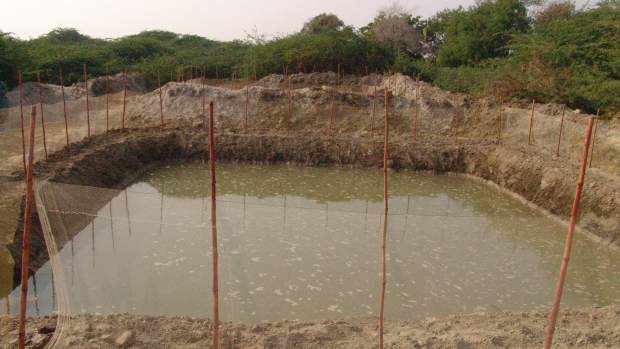Grants :: Small Grant Facilities :: Crab Fattening as an Alternative Means of Livelihood
Crab Fattening as an Alternative Means of Livelihood

Crab Fattening as an Alternative Means of Livelihood
Objectives
To introduce ten model crab fattening ponds in two coastal villages.
Background
Kharo Chhan lies along the Sindh coastline, and is home to the most dense mangrove forest in the province. As such, the area is rich in marine life and is the breeding ground for several species of fish. About ninety percent of the area’s communities are engaged in fishing, but poverty is prevalent in the region and the burden on marine resources has increased; over-fishing has become a particular problem due to the usage of small-mesh nets.
The aim of this project is to improve income generation in poor households and to introduce a sustainable approach to the utilisation of natural resources, particularly to reduce pressure on existing fish stocks. The advantage of introducing aquaculture is that most households already practise it for a living. After the purchase and rearing of juvenile crabs, they can be sold in the market. Profits can be shared among the beneficiaries, with part of it being reinvested to replenish stocks. This would ensure the sustainability of the project following its completion.
Target beneficiaries
Ten poor households in the two villages in Kharo Chhan will benefit directly, while fifteen other villages will be given knowledge on how to replicate the project.
Outputs
-
Introduce crab fattening as alternate livelihood resources and introduce 10 crab fattening ponds in two coastal villages.
-
Raise awareness and capacity among community regarding crab fattening as alternate livelihood source.
-
Documentation and dissemination of lessons learnt.
Accomplishments and challenges
- Ten model community based crab fattening ponds were introduced in three coastal villages and stocked with 2460 immature crabs for fattening and marketing linkages of beneficiaries created locally and in Karachi city.
- An exposure visit by 30 members of adjoining villages was organized to spread awareness of the benefits of mariculture.
- Fisherfolks equipped with knowledge of crab fattening and crab pond management and marketing.
- A brochure on crab pond operational guidelines developed in local language and disseminated among the fisherfolks.
- Local fisherfolks sensitized towards sustainable use of natural resources (fisheries and Mangroves).
-
Average monthly income of beneficiary households increased by approx. PKR 6000/- from the fattened crabs. Additional income from crab sale was used by a beneficiary to purchase sewing machine. The other beneficiaries used additional income to get their boat engines repaired, purchase grocery items, medicines, clothing for household use and repayment of their loans.
Contributions to cross-cutting themes
Communications
- A report on the exposure visit from members of the adjoining villages.
- Two hundred copies of a case study on the project published, along with one video clip.
- Two hundred copies of a crab pond operational guide published in the local language.
Gender Equality
Women will be involved in taking care of the juvenile crabs while the village men go fishing in the open sea; they will also take part in meetings and give their suggestions before the project is implemented.
Lessons Learned
- Through the intervention there has been a change in perceptions of local fisherfolks and the replication of crab fattening is on-going. Since the inception of the project, there has been a gradual replication of crab fattening and there has been considerable increase in crab ponds in the area. Local fishers are now looking to middlemen for immature crabs or they are collecting from wild for stocking . Beneficiaries are financially empowered and have additional amounts for nutritional items and medicine and other household uses.
- The beneficiaries reported that some crab mortality occurred during winter season. Also, due to limited or non-availability of immature crabs in wild and in local market beneficiaries faced difficulty to restock ponds.
- Crabs have good market rates during the winter season, hence more potential for fattening exists during winter.
- Pond size was 25’x25’ was found to be small, the recommended size should be at least 40’x50’.
- Capacity of VOs is enhanced in project implementation and record keeping.
- During the month of June 2014 Naunok cyclone hit Kharo Chann coastline, tidal waves damaged ponds in Yousif Katiar and Abdullah Khatti villages. Coping with the situation community repaired ponds on their self-basis.
Project Facts
Country
Location
Kharo Chhan, Sindh Province
Topic
- Sustainable Business Practices
- Sustainable Livelihoods
- Civil Society Engagement
- Gender equality
- Capacity development
Duration
5th Jul 2013 to 5th Jul 2014
MFF Grant Amount
PKR 995,000
Implementing Partner
Integrated Development and Empowerment Approaches (IDEA)
Mumtaz Rahoo
Email: rahoo@gmail.com